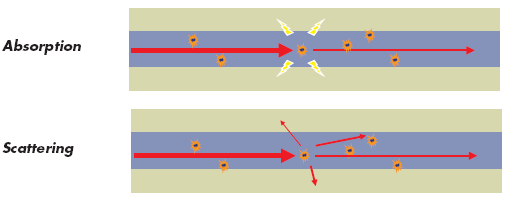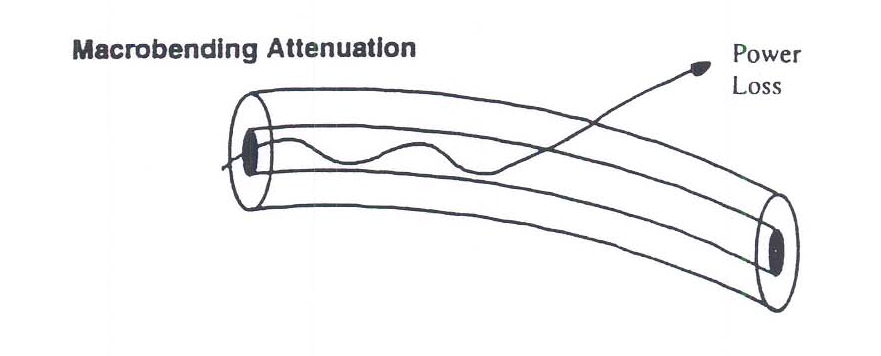When light propagates as a guided wave in a fiber core, it experiences some power losses. These are particularly important for signal transmission through fiber optic cables over long distance. For better telecommunication, we should try to decrease optical losses. Then first we need to know well about optical losses. The article will tell about intrinsic fiber losses and extrinsic fiber losses.
Intrinsic fiber losses are those associated with the fiber optic material itself. There are two kinds: scattering losses and absorption losses (see the following picture). Light is attenuated mainly because of these.

-
Absorption Losses Absorption loss is caused by absorption of photons within the fiber such as metal ions (e.g., Cu2+, Fe3+) and hydroxyl (OH–) ions. Optical power is absorbed in the excitation of molecular vibrations of such impurities in the glass. One absorption feature is that it occurs only in the vicinity of definite wavelengths corresponding to the natural oscillation frequencies or their harmonics of the particular material. In modern fibers, absorption losses are almost entirely cuased by OH–1 ions. The fundamental vibration mode of these ions corresponds to l = 2.73 µm and the harmonics at 1.37 and 0.95 µm. To reduce presence of OH1 ions, it’s possible to employ dehydration.
-
Scattering Losses Scattering losses are the second dominat influence factor to the signal attenucation in an optical fiber. This kind of loss is caused by micro variations in the fiber material density, which occur during the manufacturing process. Even though the careful manufacturing techniques is advanced and careful, most fibers are still inhomogeneous with disordered and amorphous structures. The scattering losses decrease in porption to the fourth power of the signal wavelength. So the scattering loss is a dominant loss mechanism below wavelengths of 1,000 nm. It’s also necessary in the third transmission window at the wavelengths of 1,550 nm.
These losses are specific to geometry and handling of the fibers and are not functions of the fiber material itself. There are two basic kinds and they are bending losses and connector losses.
-
Bending Losses When optical fiber cables are bent, they exhibit additional propagation losses. This is called bending losses which is a frequently encountered problem in fiber optics. Typically, these losses rise very quickly once a certain critical bend radius is reached. This critical radius can be very small (a few millimeters) for fibers with robust guiding characteristics (high numerical aperture), or it can be much larger (often tens of centimeters) for single-mode fibers. Losses are greater for bends with smaller radius.

-
Connector Losses Connector losses are related to the coupling of the output of one fiber with the input of another fiber, or couplings with detectors or other components. The losses may arise in fiber connectors and splices of the joined fibers with cores of different diameters or misaligned centers. Or the losses may occur if fibers’ axes are titled. The losses caused by mismatching of fiber diameters can be approximated by –10 log(d/D). There are other connection losses such as offsets or air gaps between fibers, and poor surface finishes.
From this article, you may know something about optical losses. To get better data transmission, you should consider the above influence factors. For intrinsic fiber losses, the products’ material is critical. For extrinsic fiber losses, note that you should try to avoid bending the fiber and do good coupling of fibers, joining fibers with the same diameters, avoid the fiber axes titled, etc.
Article source: http://www.china-cable-suppliers.com/understanding-of-optical-losses-for-better-data-transmission.html
